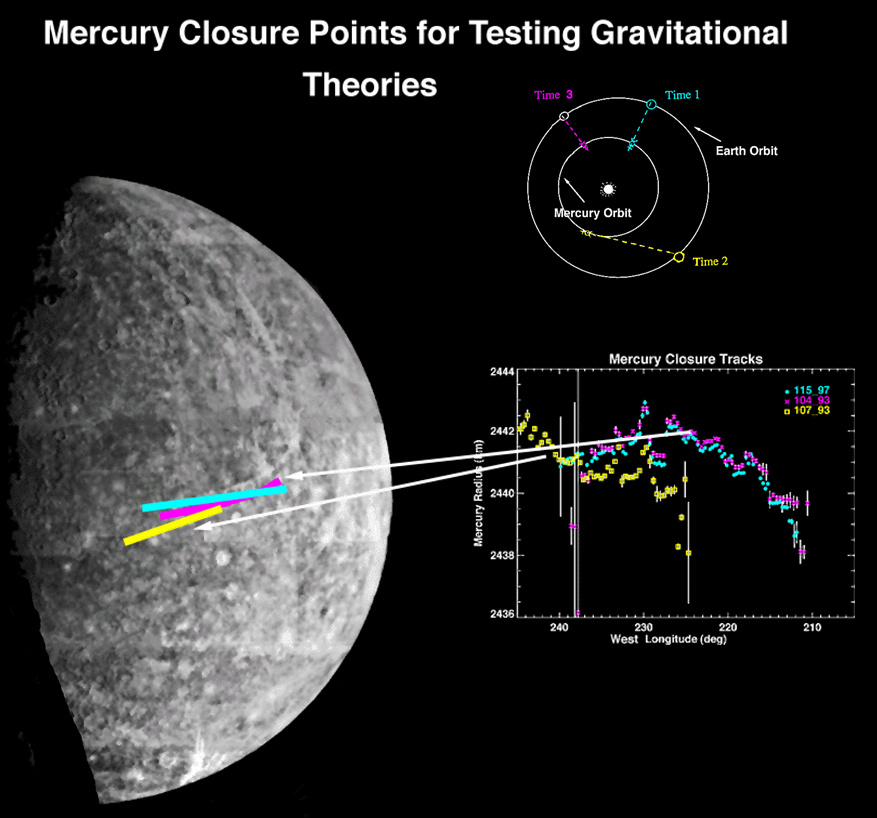
Goldstone Radar Schedule
GSSR Calendar
Galilean Satellite Goldstone-GBT Radar 2013-2014
Venus
Spin Period Radar GSSR-GBT March 2014
DSN Resource Planning Service
Goldstone Asteroid Schedule(see: "Scheduled
Goldstone Observations" link on right sidebar)
RECENT RADAR
TOPOGRAPHY OF THE LUNAR SOUTH POLE
(GIF
of topography, 336 kb)

RADAR
TOPOGRAPHY OF THE LUNAR POLES
(PDF
of Science Magazine article, 615 kb)
(PDF of IEEE Transactions Geoscience, 308 kb)
RADAR-BRIGHT
FEATURES ON
NORTH POLAR MERCURY
(PDF
abstract, 77 kb)
July 1999
GOLDSTONE/VLA
OBSERVATION OF MARS
Courtesy
B. J. Butler, M. A. Slade, R. F. Jurgens
(PDF
abstract, 87 kb)
June 25, 1999

 Rotation of Mars (209k GIF animation)
Rotation of Mars (209k GIF animation)
 Rotation of Mercury (383k GIF animation)
Rotation of Mercury (383k GIF animation)
The Planetary Radar Group is Group F in Section
332, the Communications Architectures and Research Section. We provide the
advanced engineering and we direct the development of the technology
needed to sustain and enhance the unique Goldstone
Solar System Radar.
We are the interface between scientific research
goals using the Radar and the engineering technology to accomplish
these goals.
The Radar is part of the Deep Space Network (DSN)
and is located at Goldstone in the Mojave Desert some 180 miles
north-east of Los Angeles. It is sponsored by the Interplanetary
Network Directorate (IND). It operates from the 70
meter antenna DSS-14 at the Mars site at Goldstone. We use the Radar
for investigations in planetary astronomy.
The principles of Radar operation generally require that we transmit as much power as we can, and the receiver system is as sensitive as we can make it to register the usually faint echo power reflected from the target.
We have a powerful Transmitter on the 70 meter antenna developing 500 kW at X-Band (8560 MHz, wavelength 3.5 cm). We have cryogenically cooled HEMT Low Noise Amplifiers as the first stage of the Receiver.
In order to confirm that the experiment is
proceeding successsfully, we operate with a real-time Data
Acquisition System which performs preliminary processing and displays
the currently received echo power.
The Radar can observe any accessible Solar System target. We can obtain echoes from Mercury, Venus, Mars, the satellites of Jupiter and Saturn, the Moon, and asteroids and comets. The remaining outer planets, Uranus, Neptune, and Pluto, are too distant to produce a detectable echo at Goldstone with the current equipment.
Near-Earth asteroids, in particular, such as Toutatis and Geographos are prime targets. These are increasingly prominent in scientific interest and concern. Specifically for these we have developed the Single Horn System. This allows fast switching of the radar high power radar for targets which pass close to the Earth.
We use the Radar to investigate the statistics of
Orbital Debris. This is material in low-Earth orbit resulting from
spacecraft activities and the break-up of satellites and rocket
parts. Knowledge about this is crucially important for design of
shielding for Space Station modules. The Radar is capable of sensing
rice-grained sized particles, which form a large part of the debris.
Most observations take place exclusively at
Goldstone, usually at DSS-14 alone, sometimes with DSS-13, the 34-m
antenna, as a second receiving site. Other 34-m antennas will be used
as they come on-line.
Occasionally we have joint observations with other
observing sites; e.g. we also receive radar echoes at the NRAO Very
Large Array in the New Mexico desert. We have an active scientific
and engineering collaboration with the NAIC Arecibo in Puerto Rico.
The advantages of sharing common radar data formats and data
reduction software with the Arecibo Observatory are obvious.
 Quasi-Optical Switch Movie (429k GIF animation)
Quasi-Optical Switch Movie (429k GIF animation)
Overall scientific direction of the Goldstone Radar comes from the Space and Earth Science Programs Directorate (SESPD), which in turn reports to NASA Solar System Exploration Division
In principle anyone with SMD peer-reviewed planetary
science funds may propose an experiment which needs the Radar.
There is a User's Guide which advises
nomenclature, describes the various Radar observing configurations,
and details the other requirements necessary for an observation run
or radar track.
The engineering direction of the Radar develops principally from the scientific requirements established by the Space and Earth Science Programs Directorate (SESPD). We formulate implementation efforts within JPL Division 33, working very closely with IPN 9200 Office DSN Data Systems which has overall responsibility for DSN Implementation Engineering.
Many of the features in the Radar are unique in the DSN and also in the world. The successful operation of the world's most powerful X-Band continuous wave (CW) transmitters in particular requires dedicated and extensive expertise. The GSSR still aims to develop and integrate new technologies such as the all-digital JPL Block V Receiver, to improve the science return and operational reliability.
It is our purpose to increase productivity of antenna use, to get more and better images per transmitted photon per transmitter second.
See Near-Earth Object Program or go directly to Near-Earth Object Surveys and Hazard Mitigation Strategies: Final Report from January 2010
Last Update: 15 January 2016
Send comments to: Martin Slade -- Martin.A.Slade[at]jpl.nasa.gov